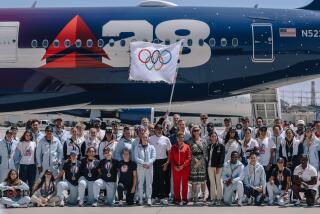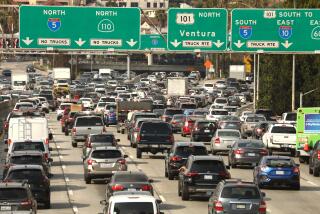Clear Winners Hope to Emerge at Car Challenge
- Share via
The clean-car movement’s version of the Olympic Games comes to the United States this week to raise public awareness about alternative fuels and power plants in personal transportation.
After hovering in the shadows for years, the movement may be gaining importance because of renewed fears of Mideast supply disruptions and calls for reduced U.S.-dependence on imported oil.
The three-day competition, called the Challenge Bibendum, is sponsored by Michelin Group of France. From Friday through Sunday, the event will test the mettle of more than 60 entries, from prototype fuel-cell and hybrid vehicles built by giant auto companies to one-of-a-kind, environmentally friendly cars cobbled together by independent developers.
The field even includes a hydrogen-burning sports car from racing great Carroll Shelby and a 1994 Buick station wagon with a stock internal combustion engine adapted to run on a mixture of hydrogen and hydrocarbon compounds--one of four vehicles entered by actor and longtime environmental activist Dennis Weaver.
Figuring out how to judge such a disparate group and accurately compare their performance--to one another and to conventional autos with gasoline engines--is the job of the Automobile Club of Southern California, the Bibendum’s sanctioning body in the United States.
Vehicles that run on fuel cells, for example, will score well in emissions testing; these entrants use hydrogen to generate electricity, leaving heat and trace amounts of water as the principal waste products. But there is no expectation of a retail market for such vehicles before the end of the decade, if then.
Weaver, a strong proponent of hydrogen, said the systems used in two of the entries from his Colorado-based nonprofit Institute of Ecolonomics--a coinage blending “ecology” and “economics”--are meant to “address the cars on the road now.”
“We are looking at being able to retrofit existing cars to run on hydrogen that is produced on board the vehicle, while fuel cells require production of all-new cars,” he said.
Other entries include cars that run on fuels refined from plant material, as well as those using diesel, compressed natural gas, hydrogen, gasoline, liquid propane gas, gasoline-electric hybrid systems and a hybrid of hydrogen and natural gas.
“The point of the Challenge is to get these technologies out there so people can see what they are and how they work,” said Steve Mazor, chief automotive engineer for the Auto Club. But with nearly every entrant a proponent of a different technology, making sure it all makes sense when the judging is over is a challenge all its own, he said.
Mazor developed a test system that will judge the Bibendum entries on many of the same criteria the Auto Club uses in testing conventional vehicles: acceleration, braking, fuel efficiency and range, emissions, noise levels generated by the vehicles (instead of levels inside the passenger compartments) and handling through a 360-foot slalom course.
“They will be driven the way real people really drive every day,” Mazor said. “People are hesitant to buy a clean vehicle just because it is clean. They want to know that it meets their performance needs.
And studies have shown that if the vehicle does meet their needs, people are willing to pay a little bit of a premium--not much, but a little--to buy a clean-running car.”
Fuel economy will be measured in a road test that requires several stages of acceleration and deceleration over a 100-mile route.
All fuel usage will be converted to miles-per-gallon equivalents so that the gallons of diesel or gasoline consumed by some entries will make sense when compared with the cubic feet of natural gas, pounds of hydrogen or kilowatt hours of electricity consumed by others.
A separate design evaluation by an international jury of experts will be conducted Friday, the first day of the event, when the cars will be displayed at the Auto Club headquarters at 2601 S. Figueroa St. in downtown Los Angeles.
Most performance testing will be conducted Saturday at the California Speedway in Fontana. Final results will be announced Sunday after a 275-mile road test in which competing vehicles will be driven from Fontana to Las Vegas, a route that includes the tough climb over the 4,000-foot elevation of the Baker Grade.
The Challenge Bibendum--named for the rotund Michelin man character used in the tire maker’s advertising--was first held in France in 1998 and was repeated there last year. The two European events each drew about 50 entries.
Edouard Michelin, the environmentally active chief executive and managing partner of Michelin Group, said the event is a reality check on the state of alternative automotive technologies.
“The challenge today is to adapt and reconcile our demands for a fast, enduring, comfortable and affordable transportation with the new demands for cleaner, quieter cities and the transportation that will be as sustainable in the emerging countries of the world as it is in the industrialized nations,” he said.
“Showcasing what the automotive industry is doing to meet this challenge and encouraging us all to continue our efforts is what the Michelin Challenge Bibendum is all about.”
More to Read
Go beyond the scoreboard
Get the latest on L.A.'s teams in the daily Sports Report newsletter.
You may occasionally receive promotional content from the Los Angeles Times.






